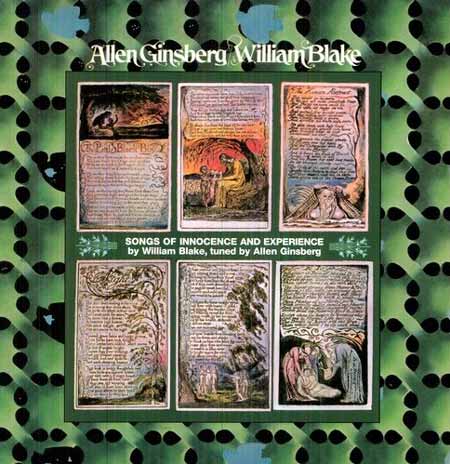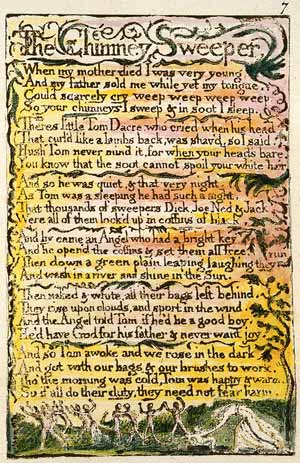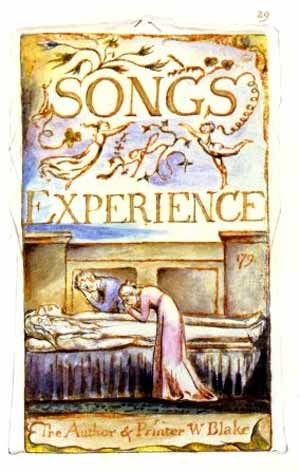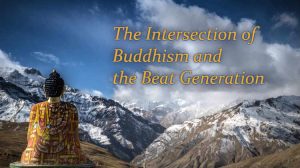William Blake’s Songs of Innocence and of Experience (1789) is a collection of illuminated poems separated into two groupings, Songs of Innocence and Songs of Experience, that engage with their respective, eponymous forces and ostensibly present them as a dichotomy, or perhaps rather as a linear transition, with innocence giving way to experience. But to consider the poem a presentation of binaries or opposing forces, discounts much of the Blakean aesthetic. For me, it wasn’t just the text and the accompanying illustrations that helped to frame and reify the dialectical counterbalance between innocence and experience in Blake’s work, but rather the addition of a third dimension: Allen Ginsberg’s musical rendition of the work, available through PennSound. It’s through Ginsberg’s off-key, warbling, sometimes out-of-time, performance of the lyric that we get a simultaneous embracing of the Romantic ideology and the Modernist rejection of it, coexistent and counterbalanced to great aesthetic effect.
Content and form of the original poems
First, a little on my view of Blake’s work. The presentation of Blake’s poem, the separation into groupings of innocence and of experience, would imply that each grouping is discrete and addresses solely its own force. But that’s not how Blake’s collection works. It begins with the presentation of innocence, focusing on youth and pastoral imagery as a kind of thesis, but intersperses challenges to the purity of innocence, such as slavery and child labor.

Through this impingement of Experience upon Innocence’s textual ground, it would be tempting to assume that Blake would chart a linear progression, with an inverse relationship between innocence and age (for which experience is an ostensible proxy or metonymy). Similarly, in Songs of Experience, we see the focus shift to the apparent corruption of innocence: the turn toward death of the vegetal imagery (a symbol of innocence) in “The Sick Rose,” a formerly fertile pastoral space turned fallow in “The Garden of Love,” etc. But the balancing factor of this antithesis is the form, both the poetic and visual form of the work. The ballad-esque forms that project the feel of a soccer supporters club singing in a crowded pub and the bright, Technicolor images that display a kind of childlike, Crayola vibrancy even in their depiction of dark subject matter both serve to illustrate (literally) the encroachment of Innocence upon Experience.
When I first read the work, I was expecting to see a kind of Hegelian dialectic take shape: thesis (Innocence) collides with antithesis (Experience), with the residue of the collision, the synthesis (death?), resolving, in time, the conflict. But what we actually get is a non-Hegelian dialectic, similar to the way Henry Sayre describes William Carlos Williams’ dichotomy between reality and the imagination. It’s not that one force is the established hegemony and a challenger will seek to supplant it, but rather that the two forces can and do coexist symbiotically, even if ostensibly opposed. Innocence needs Experience to care for it. We see this repeatedly throughout the poems—imagery of shepherds and mothers and nurses representing Experience’s nurture of Innocence. Later, we see the content turn dark, toward Experience, but the form seeks to counterbalance it through interspersed innocence, including youth as a palliative presence in “London,” and the persistent presence of vegetation as a symbol of innocence. Through this disjuncture, Innocence offers its help to Experience. It seeks to show that reality is constructed through perception, through the imagination (as WCW would claim over a century later), and that Innocence is ever-present and can be invoked at any point to act as a counterbalance. In this manner, we get two contingent and interdependent forces, which can never devolve into one superseding the other, nor a Hegelian synthesis. It’s perhaps Kantian, in that innocence is tied to perception (phenomena) and experience gets bound up in an immutable reality, a progression toward death (noumena). We can’t altogether avoid the noumenal reality of things, but we can and do construct a phenomenal reality through perception. Blake suggests that this process can be conscious—innocence can be recalled and applied to temper experience—in much the same way Williams calls upon the imagination to temper reality.
Ginsberg’s performance of the collection
While Ginsberg offers a unique interpretation of the Songs through his musical renditions, I find that listening while looking at the original illuminated texts provides the best feel for how Ginsberg extends and complements the content and form aurally.
Starting from the first song, the introduction to Innocence, the poem describes a biblical divine inspiration, wherein a piper meets a messianic child on a cloud who is moved by his song. The child asks the piper to “pipe a song about a Lamb”—note the capitalization here, likely an allusion to the Christian “Lamb of God” and reflexive to the child who requests it. From there, the child asks the piper to sing, and then finally to write. The order here should not be overlooked. This subordination would be echoed by poets from Ezra Pound (“music begins to atrophy when it departs too far from the dance…poetry begins to atrophy when it gets too far from music”) through Olson (written poetry as derivative of kinesis and human breath) through Vachel Lindsay (who saw written poems as librettos to sung/performed poems). So the progressions goes: melody to song to text, the latter being necessary for preservation, though inferior to the former options. This framing works well for Ginsberg’s performance, where he becomes the inspired, revitalizing the textual representations of the Songs into their intended sung forms. As discussed in the PoemTalk on this work, he becomes the bard who composes and sings these songs to us, through a divine inspiration.

Most interesting to me in terms of musical arrangement is the lack of drums in Innocence, and their appearance on certain tracks in Experience. To me, this is a crucial detail, as drums mark regular time and evoke the metronome, an anathemized symbol in the modernist aesthetic—“compose in the sequence of the musical phrase, not in the sequence of the metronome,” said Pound—for its association with mechanized poetic forms. The introduction of drums in “The Garden of Love” and culminating in “The Grey Monk,” (though this work is not part of Blake’s Songs of Experience) with drum legend Elvin Jones playing on the latter, to me connotes a conscious aesthetic choice to chart a course toward the Romantic aesthetic of poetry, as innocence becomes background to experience. To counterbalance the Romantic ideology, we have Ginsberg’s warbling, whimsical, out-of-key vocals continuing to evoke Innocence, now impinging upon Experience, through their association with childlike revelry. Herein do we get an aural, non-Hegelian dialectic taking shape.
Finally and most importantly, I would note the increased degree of production and polish we can perceive when we arrive at the final song in Ginsberg’s Songs of Experience, “The Grey Monk.” The fact that this track is appended to the album is an interesting aesthetic decision itself, as “The Grey Monk” is not part of Blake’s Songs of Experience. Ginsberg’s decision to include it as a conclusion seems to signify where he thinks the Songs‘ logical end-point lies should innocence be depleted: violence and renewed tyranny. Only an “intellectual thing” like a tear, which also has religious connotations of contrition, forgiveness, and thus return to innocence, can restore balance.

And so I propose that, not only do we get a dialectical balance between innocence and experience in Ginsberg’s rendition of Blake, but so too an interplay between Romanticism and Modernism. And all of this is made present by the aural facets and production choices made in the creation of the album. In this way, Ginsberg helps us to perceive both the complexity of Blake’s work and Blake’s position as a proto-modernist.





Leave a Reply